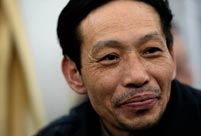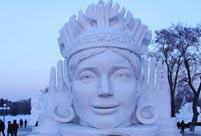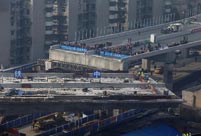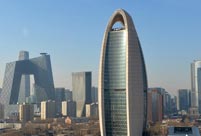 Int'l Snow Sculpture Art Expo in Harbin
Int'l Snow Sculpture Art Expo in Harbin Sichuan money wall for dividend payment
Sichuan money wall for dividend payment Li Na crashes Belinda Bencic in 2nd round at Australian Open
Li Na crashes Belinda Bencic in 2nd round at Australian Open
 Shocking moments when PLA's weapons open fire
Shocking moments when PLA's weapons open fire Famous Lanzhou beef noodles
Famous Lanzhou beef noodles Armed Police hold anti-terrorism drill in SE China's Xiamen
Armed Police hold anti-terrorism drill in SE China's Xiamen Harbin Int'l Ice and Snow Festival opens
Harbin Int'l Ice and Snow Festival opens 'Jin' named the word of the year by cross-strait netizens
'Jin' named the word of the year by cross-strait netizens Chinese scientific expedition goes to build new Antarctica station
Chinese scientific expedition goes to build new Antarctica station
During an interview with Foreign Affairs last May, Japanese Prime Minister Shinzo Abe compared Japan's Yasukuni Shrine with the Arlington National Cemetery of the US, claiming that both honor war dead who sacrificed for their country.
"About the Yasukuni Shrine, let me humbly urge you to think about your own place to pay homage to the war dead, Arlington National Cemetery, in the United States. The presidents of the United States go there, and as Japan's prime minister, I have visited," the Japanese Prime Minister said, and he matched his words with a high-profile visit to the shrine on December 26, 2013.
The following is an article published on The National Interest's website January 16 by Mindy Kotler, director of Asia Policy Point, a Washington-based non-profit research center, who refutes Abe's analogy and calls Japan's World War II shrine "a place of defiance, not memory".
Sorry, Japan: Yasukuni Is Not Arlington
Japan’s prime minister Shinzo Abe made a well-planned and well-publicized visit to the Yasukuni Shrine on Christmas Day in the United States. The Shrine gives special recognition to war criminals tried after Japan's surrender in 1945 and has long been an unhappy reminder of the vast damage Japan inflicted upon Asians and Westerners during World War II. Nevertheless, Abe brushed aside criticism by saying that going to Yasukuni is no different than an American president’s visit to Arlington National Cemetery.
This analogy is mistaken, and the differences between the two places explain why the Prime Minister's visit is so provocative. The two memorials share neither the same history nor spirit. Although both were the result of civil wars, Yasukuni now focuses on the idealization of the Pacific Theater of WWII, while Arlington records the continuing sorrow of a nation.
Arlington National Cemetery was created from the estate of General Robert E. Lee, commander of the Confederacy’s armies. Occupying Union Brig. Gen. Montgomery C. Meigs appropriated the grounds around the mansion in 1864 to use as a military cemetery. Meigs wanted to ensure that if the Lee family returned, tombstones and widows in mourning would surround their home. The intent was for Lee's estate to symbolize the pain and suffering caused by the South's engaging in the Civil War.
Unlike Yasukuni, Arlington is a cemetery. The bodies or ashes of those who served and their family members are interred on the grounds. The fallen will continue to rest there as long as the United States exists.
None of this is true at Yasukuni. It is a religious shrine established in 1869 to embed the supremacy of the Shinto faith, the divinity of the Emperor, and the centrality of the Imperial institution into the national polity. At Yasukuni, those fighting for the Emperor from the civil wars of mid-nineteenth century Japan through the end of the Pacific War were transformed into divine spirits to join as one with the Emperor. Here the common foot soldier was rewarded in death by becoming equal to the Emperor.
At Arlington, men and women of all religions and races are buried. At Yasukuni only Shinto is practiced and only the souls of identified and approved members of Imperial Japan's military who died on the battlefield can be apotheosized with the Emperor. There are many exceptions, such as the fourteen Class A war criminals who were hanged or died in Sugamo Prison after the Pacific War. Further, some Japanese social classes are not allowed; and the unknown are not represented.

 A 60-hour journey home
A 60-hour journey home Int'l Snow Sculpture Art Expo
Int'l Snow Sculpture Art Expo Highlights of China's air force
Highlights of China's air force Airline crew stage flashmob dance at Kunming airport
Airline crew stage flashmob dance at Kunming airport Top15 countries to retire to in 2014
Top15 countries to retire to in 2014 Hot supermodel's new photo album released
Hot supermodel's new photo album released Asia's heaviest box girder finishes 'rotation' in Wuhan
Asia's heaviest box girder finishes 'rotation' in Wuhan Completed facade of People's Daily new headquarters
Completed facade of People's Daily new headquarters Chinese-branded car passes North America standard safety test for the first time
Chinese-branded car passes North America standard safety test for the first time Li Na beats Bouchard to reach Australian final
Li Na beats Bouchard to reach Australian final  Explore the sources of PM 2.5
Explore the sources of PM 2.5 Highlights of Chinese airborne troops'exercises
Highlights of Chinese airborne troops'exercises  'Living in ice house' competition held in central China
'Living in ice house' competition held in central China  Chinese figure in Oscar nominations
Chinese figure in Oscar nominations  Top ten aerospace events in China 2013
Top ten aerospace events in China 2013Day|Week|Month